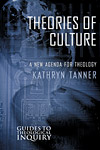Theories of Culture: A New Agenda for Theology
Book Review
 Title: Theories of Culture: A New Agenda for Theology
Title: Theories of Culture: A New Agenda for Theology
Author: Kathryn Tanner and Paul Lakeland, Eds.
Publisher: Minneapolis: Fortress Press, 1997
Reviewed by: Nell Becker Sweeden, Ph.D. Student in Practical Theology
In Theories of Culture: A New Agenda for Theology, Kathryn Tanner opens her first chapters with a comprehensive view of the development of cultural theory and brings this into conversation with theological engagement in the second half of her book. The substance of Tanner’s argument lies in the last three chapters, in which she relies on postmodern cultural theory to engage theology toward a hybrid and ad hoc task of deepening Christian discipleship in various contexts. The bulk of her argument challenges the postliberal conception of theology as an alternative social way of life imbedded within Christian social practices. Additionally, she challenges Troeltschian episodic cultural engagement, or situation-appropriate application and interpretation, and Gadamerian correlationist approaches of tradition as transmission to culture. Tanner’s ultimate concern is to challenge a theology controlled by cultural dominance—such as preassigned cultural continuity or transmission—or theology confined to reductionism and boundaries. In turn, she seeks an openness to theological engagement with culture that allows for the free movement of God’s grace. Her new agenda for theology is to open up Christian communities of healthy argument toward further creativity and diversity in Christian engagement with the world.
Tanner’s challenge to postliberal theology concentrates on George Lindbeck’s and John Milbank’s approaches. With regard to Milbank, Tanner finds that the possibility of maintaining an alternative Christian social world is difficult to sustain empirically (99). Lindbeck’s cultural-linguistic approach also fosters cultural insularity regarding diverse cultural expression within Christianity. Her challenge to both of these approaches is derived from postmodern cultural theory which articulates a more complicated and ad hoc approach to cultural identity. Tanner finds that postliberal theological approaches can be helpful, but also over simplified. She writes: “One can still agree with postliberal theology that the identity of a Christian way of life is formed by a cultural boundary. This is not, however, the sharp boundary of independent cultural contents as postliberalism at its extreme imagines. The boundary is, instead, one of use that allows Christian identity to be essentially impure and mixed, the identity of a hybrid that always shares cultural forms with its wider host culture and other religions…”(114).
More specifically Tanner does not find that Christian practices and virtues to be able to be isolated from the overlapping activities and memberships Christians encounter within the world. Christian social practices are a part of wider society rather than alternative to or separate from them. She sees postliberal approaches reducing Christian diversity into uniformity of cultural expression. In turn, Tanner proposes a more ad-hoc use of various strategies; guided by the case-by-case judgment of particulars. Her ecclesiological direction is toward “a genuine community of argument, one marked by mutual hearing and criticism among those who disagree, by a common commitment to mutual correction and uplift, in keeping with the shared hope of good discipleship, proper faithfulness, and purity of witness” (123-4). While her proposal is not in conflict with postliberal theology, Tanner here seeks to highlight the need to disagree within communities in order to allow for creativity and diversity in both divine and human expression—theology born out of struggle rather than uniformity. She finds that “In their effort to maintain Christian identity, postliberals are in danger of confusing subordination to the Word with subordination to a human word” (149).
Tanner’s concern is to allow the Spirit to blow freely and not be scripted by human demands (120). In this sense, she simplifies Christian identity to “remaining open to direction for the free grace of God in Christ” (149). In order to do this Tanner sets out some specifics with regard to Christian identity from a postmodern cultural perspective—the diversity of Christian practices are united in a task, rather than pre-scripted by rules or method of investigation (153). Similarly, Christian identity can no longer be determined by “group specificity, sharp cultural boundaries, or homogeneity of practices” (151-2). The boundaries between Christian and non-Christian ways of life cannot be easily separated, but are permeable characteristic of hybrid formulations. And, contrary to postliberal perspectives, what unites Christians are not common practices, but concern for true discipleship.
While Tanner seeks to avoid cultural dominance within Christianity and human prescription of God working in the world, her project is not without its own risks and reductions. She wrestles with the tension of remaining open, but also risks a reduction that leaves Christian identity lacking in substance and conviction. It also remains unclear of what true discipleship consists. Her descriptions remain limited to a watered-down, specifically reformed position of justification by faith, without much tribute to the convictions of other theological traditions. Her approach is open, characteristic of stretching and challenging neat conceptual categories and easily discerned boundaries within theology. For this it is to be commended. At the same time, she opens up herself and her new agenda for theology to this same ongoing struggle. In this way, I will give her credit for but also hold her accountable to the same critiques she poses to others. A new agenda for theology is not complete without its own ‘agenda’. Thus, her argument includes an important postmodern task of holding together, tinkering, and creating ‘bricoleur’ out of a potentially messy reality (166). But, at the same time, her argument also circles back upon itself and risks remaining vague and reductionstic. These are the inherent risks of the form of her argument within a work that specifically addresses and challenges academic theologians; what remains to be investigated are the concrete manifestations of communities of argument and struggle seeking deeper discipleship in hybrid formulations.